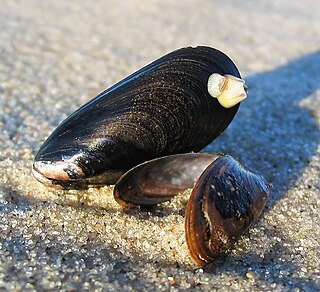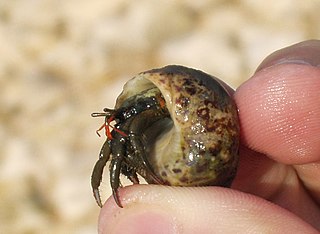
Mussel is the common name used for members of several families of bivalve molluscs, from saltwater and freshwater habitats. These groups have in common a shell whose outline is elongated and asymmetrical compared with other edible clams, which are often more or less rounded or oval.

The blue mussel, also known as the common mussel, is a medium-sized edible marine bivalve mollusc in the family Mytilidae, the mussels. Blue mussels are subject to commercial use and intensive aquaculture. A species with a large range, empty shells are commonly found on beaches around the world.

The dog whelk, dogwhelk, or Atlantic dogwinkle, scientific name Nucella lapillus, is a species of predatory sea snail, a carnivorous marine gastropod in the family Muricidae, the rock snails.

Whelk is a common name that is applied to various kinds of sea snail. Although a number of whelks are relatively large and are in the family Buccinidae, the word whelk is also applied to some other marine gastropod species within several families of sea snails that are not very closely related.
Imposex is a disorder in sea snails caused by the toxic effects of certain marine pollutants. These pollutants cause female sea snails to develop male sex organs such as a penis and a vas deferens.

Rapana venosa, common name the veined rapa whelk or Asian rapa whelk, is a species of large predatory sea snail, a marine gastropod mollusc or whelk, in the family Muricidae, the rock shells.

Thais, sometimes known by the common names dog winkles or rock shells, is a genus of medium to large predatory sea snails with an operculum, marine gastropod mollusks in the family Muricidae, the rock shells.

Mytilidae are a family of small to large saltwater mussels, marine bivalve molluscs in the order Mytilida. One of the genera, Limnoperna, inhabits brackish or freshwater environments. The order has only this one family which contains some 52 genera.

Perna perna, the brown mussel, is an economically important mussel, a bivalve mollusc belonging to the family Mytilidae. It is harvested as a food source but is also known to harbor toxins and cause damage to marine structures. It is native to the waters of Africa, Europe, and South America and was introduced in the waters of North America.

Mytilopsis leucophaeata is a species of small bivalve mollusc in the false mussel family, Dreissenidae. It is commonly known as Conrad's false mussel or the dark false mussel.

Clibanarius erythropus is a species of hermit crab that lives in rockpools and sublittoral waters. It is found in the Mediterranean Sea, Black Sea and eastern Atlantic Ocean from the Azores to Brittany, the Channel Islands and as far north as the south Cornwall coast. Individuals may grow up to a carapace length of 15 millimetres (0.6 in).

Stramonita haemastoma, common name the red-mouthed rock shell or the Florida dog winkle, is a species of predatory sea snail, a marine gastropod mollusc in the family Muricidae, the rock snails.

The Mediterranean mussel is a species of bivalve, a marine mollusc in the family Mytilidae. It is an invasive species in many parts of the world, and also an object of aquaculture.

Patella ferruginea, commonly known as the ribbed Mediterranean limpet, is a species of sea snail, a true limpet, a marine gastropod mollusk in the family Patellidae, one of the families of true limpets. It is a large limpet, native to the western Mediterranean Sea, and although common in the past, it is now rare and restricted to only a few locations.

Mytilaster is a genus of marine mussels from the warmer waters of the Atlantic Ocean and Mediterranean Basin. The type species is Mytilaster lineatus.
Brachidontes is a genus of mussels in the family Mytilidae.

The thinstripe hermit crab, Clibanarius vittatus, is a species of hermit crab in the family Diogenidae. It is found in the Caribbean Sea, the Gulf of Mexico and the western Atlantic Ocean.

Brachidontes pharaonis is a species of mussel from the family Mytilidae. It is native to the Indian Ocean and the Red Sea, and has colonised the Mediterranean Sea where it is regarded as an invasive species.

Arcuatula senhousia, commonly known as the Asian date mussel, Asian mussel or bag mussel, is a small saltwater mussel, a marine bivalve mollusk species in the family Mytilidae, the mussels. Other common names for this species include: the Japanese mussel, Senhouse's mussel, the green mussel, and the green bagmussel.
Aspidosiphon elegans is a species of unsegmented benthic marine worm in the phylum Sipuncula, the peanut worms. It is a bioeroding species and burrows into limestone rocks, stones and corals. It occurs in the western Indo-Pacific region, the Red Sea, and the tropical western Atlantic Ocean, and is invasive in the eastern Mediterranean Sea.

















